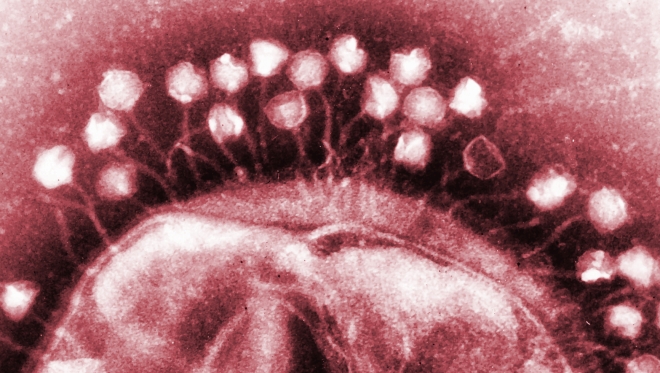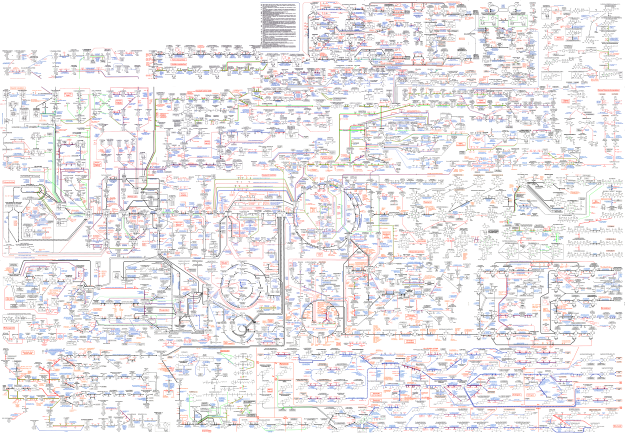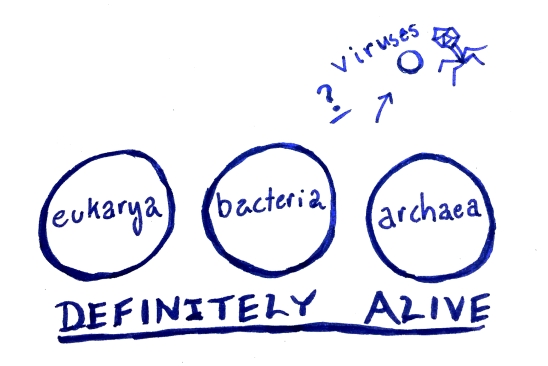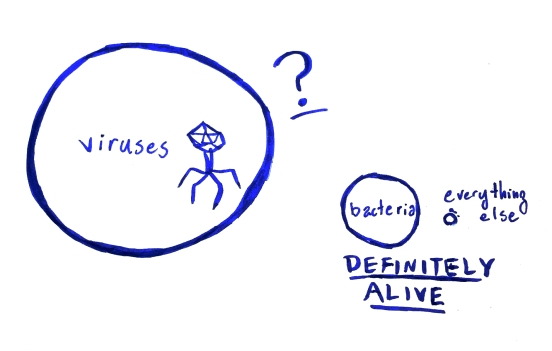Whether viruses are alive or not is a silly question. Here’s why.
(I make a handful of specific claims here that I expect are not universally agreed upon. In the spirit of tagging claims and also as a TL;DR, I’ll list them.)
- Whether things are alive or not is a categorization issue.
- The criteria that living organisms should be made of cells is a bad one, even excluding viruses.
- Some viruses process energy.
- A virus alone may not process energy, but a virus-infected cell does, and meets all criteria for life.
- Viruses are not an edge case in biology, they’re central to it.
- The current criteria for life seem to be specifically set up to exclude viruses.

Bacteriophage infecting a cell. || Electron micrograph by Dr. Graham Beards, CC BY-SA 3.0
What does it mean to be alive?
Whether viruses are alive is a semantic issue. It isn’t a question about reality, in the same way that “how many viruses are there?” or “do viruses have RNA?” are questions about reality. It’s a definitional question, and whether they fall in the territory of “alive” or not depends on where you draw the borders.
Fortunately, scientists tentatively use a standard set of borders. This is not exactly set in stone, but it’s an outset. In intro biology in college, I learned the following 7 characteristics (here, copied from Wikipedia)*:
-
Homeostasis: regulation of the internal environment to maintain a constant state; for example, sweating to reduce temperature
-
Organization: being structurally composed of one or more cells — the basic units of life
-
Metabolism: transformation of energy by converting chemicals and energy into cellular components (anabolism) and decomposing organic matter (catabolism). Living things require energy to maintain internal organization (homeostasis) and to produce the other phenomena associated with life.
-
Growth: maintenance of a higher rate of anabolism than catabolism. A growing organism increases in size in all of its parts, rather than simply accumulating matter.
-
Adaptation: the ability to change over time in response to the environment. This ability is fundamental to the process of evolution and is determined by the organism’s heredity, diet, and external factors.
-
Response to stimuli: a response can take many forms, from the contraction of a unicellular organism to external chemicals, to complex reactions involving all the senses of multicellular organisms. A response is often expressed by motion; for example, the leaves of a plant turning toward the sun (phototropism), and chemotaxis.
-
Reproduction: the ability to produce new individual organisms, either asexually from a single parent organism or sexually from two parent organisms.
The simple answer
Viruses meet all of the criteria for living things, except 2) and maybe 3).
The complicated answer
For the complicated answer, let’s go a level deeper.
Simply put, criterion 2) states that living things must be made of cells.
Criterion 3) states that living things must metabolize chemical energy in order to power their processes.
Are viruses made of cells?
Definitely not.
Okay, here’s what I’ve got. I think 2) is a bad criterion. I think that criteria for living things should not be restricted to earth *, and therefore not restricted to our phylogenetic history. Cells are a popular structure on earth, but if we go to space and find large friendly aliens that are made of proteins, reproduce, evolve, and have languages, we’re not just going to call them “non-living” because they run on something other than cells. Even if that definition is useful up until that point, we’d change it after we found those aliens, suggesting that it wasn’t a good criterion in the first place either.
(Could large aliens not be made out of cells? Difficult to say – multicellularity has been a really, really popular strategy here on earth, having evolved convergently at least 25 times. But cells as we know them only evolved once or twice. Also, it’s not clear to what degree convergent evolution applies to things outside of our particular evolutionary history, because n=1.)
So no, viruses don’t meet criterion 2), although the importance of criterion 2) is debatable.
Do viruses process energy?
What about criterion 3)? Do viruses process energy? Kind of.
Let’s unpack “processing energy.” Converting one kind of chemical energy to another is pretty generic. In bacteria and eukaryotes, what does that look like?

Some metabolic pathways used by cellular life. Large version.
Go ahead. Enlarge it. Look around. Contemplate going into biochemistry. Here’s where it starts to get complicated.
One of the major energy sources in cells is converting adenosine triphosphate (ATP) into adenosine diphosphate (ADP). This transformation powers so much cellular processes in all different organisms that it’s called the currency of life.
Bacteriophage T4 encodes an ATP→ADP-powered motor. It’s used during the virus’ reproduction, to package DNA inside nascent virus heads.
Some viruses of marine cyanobacteria encode various parts of the electron transport chain, the series of motors that pump protons across membranes and create a gradient that results in the synthesis of ATP. They encode these as a sort of improvement on the ones already present in the hosts.
Do those viruses process chemical energy? Yes. If you’re not convinced, ask yourself: Is there some other pathway you’d need to see before you consider a virus to encode a metabolism? If so, are you absolutely certain that we will never find such a virus? I don’t think I would be.
Wait, you may say. Sure, the viruses encode those and do those when infecting a host. But the viruses themselves don’t do them.
To which I would respond: A pathogenic bacterial spore is, basically, metabolically inert. If it nestles into a warm, nutrient-rich host, it blossoms into life. Our understanding of living things includes a lot of affordance for stasis.
By the same token, a virus is a spore in stasis. A virus-infected cell meets all the criteria of life.
(I think I heard this idea from Lindsay Black’s talk at the 2015 Evergreen Bacteriophage meeting, but I might be misremembering. The scientists there seemed very on-board with the idea, and they certainly have another incentive to claim that their subjects are alive, which is that studying living things sounds cooler than studying non-living things – but I think the point is still sound.)
Do we really want only some viruses count as alive?
To summarize, cells infected by T4 or some marine cyanophages – and probably other viruses – meets all of the criteria of life.
It seems ridiculous to include only those viruses in the domain of ‘life’, and not others that don’t include those chemical processes. Viruses have phylogeny. Separating off some viruses that are alive and some that aren’t is pruning branches off of the the evolutionary tree. We want a category of life that carves nature at its joints, and picking only some viruses does the opposite of that.
Wait, it gets more complicated. Some researchers have proposed giant viruses as a fourth domain of life (alongside the standard prokaryotes, eukaryotes, and archaea.) You’ll note that it’s giant viruses, and not all the viruses. That’s because viruses probably aren’t monophyletic. Hyperthermophilic crenarchaea phages, in addition to being a great name for your baby, share literally no genes with any other virus. Some other viruses have only extremely distant genetic similarities to others, which may have been swapped in by accident during past infections. This is not terribly surprising – we know that parasites have convergently evolved perhaps thousands of times. But it certainly complicates the issue of where to put viruses in the tree.
Viruses are not just an edge case
When people talk about the criteria of life, they tend to consider viruses as an edge case, a weird outlier. This is misleading.

The standard view of life

A more cosmopolitan view.
Worldwide, viruses outnumber cells 10 times over. They’re not an edge case in biology – by number of individuals, or amount of ongoing evolution, they’re most of biology. And it’s rather suspicious that the standard criteria for life seem to be set up to include every DNA-containing evolving organism except for viruses. If we took out criteria 2) and 3), what else would that fold in? Maybe prions? Anything else?
Accepting that ‘life’ is a word that tries to draw out a category in reality, why do we care about that category? When we ask “is something alive?”, here are some questions we might mean instead.
- Is something worth moral consideration? (Less than a bacteria, if any.)
- Should biologists study something? (A biologist is much more suited to study viruses than a chemist is.)
- Does something fit into the tree of life? (Yes.)
- If we find something like it on another planet, should we celebrate? (Yes, especially because a parasite has to have a host nearby.)
When we think of viruses – fast moving, promiscuous gene-swappers, picking up genes from both each other and their hosts, polyphyletic, here from the beginning – I think of a parasitic vine weaving around the tree of life. It’s not exactly an answer, but it’s a metaphor that’s closer to the truth.
* Carl Sagan’s definition of life, presented to and accepted by a committee at NASA, is “a self-sustaining chemical system capable of Darwinian evolution.” This nicer, neater definition folds in viruses, prions, and aliens. The 7-point system is the one I was taught in college, though, so I’m writing about that.

